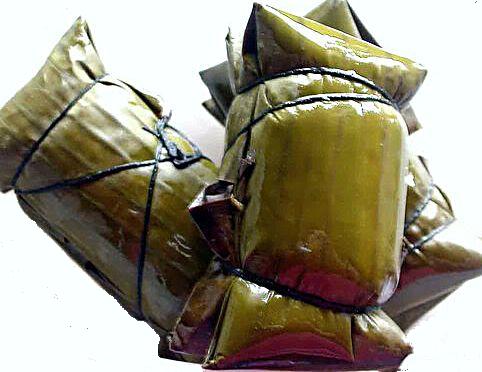 Suman is native rice cake wrapped in banana leaves, and made of glutinous rice (malagkit na bigas) cooked in coconut milk, brown sugar and salt. Suman was originated in the Philippines. Suman is also known as Budbud in Visayan dialects in other parts of the Philippines.
Suman is native rice cake wrapped in banana leaves, and made of glutinous rice (malagkit na bigas) cooked in coconut milk, brown sugar and salt. Suman was originated in the Philippines. Suman is also known as Budbud in Visayan dialects in other parts of the Philippines.
There are different rice cakes all over the Philippines. And what makes them distinctive with other rice cakes around the Philippines is the unique chewy sweet taste. Among them are:
- Binuo (or Suman sa Binuo) – A rare variety of suman, the glutinous rice is soaked, milled, mixed with coconut milk and sugar, wrapped in the leaves of the Tagbak plant, and steamed. The leaves give this variety of suman a uniquely balmy, minty flavor, and the suman itself is chewier than the whole-rice varieties.
- Suman sa Ibus – An ubiquitous variety of suman in the Philippines, the glutinous rice is washed, and is then mixed with salt and coconut milk. The mixture is poured over pre-made coil containers of young palm leaves called Ibus, and fixed with the leaf’s central shaft. This is then steamed using water mixed with “luyang dilaw” (Turmeric) – giving it that distinctly yellow colour – and served either with a mixture of shredded coconut and sugar, or latik – (reduce coconut milk until white lumps form and simmer until golden brown).
- Suman sa Inantala – The ingredients are similar to the Ibus variety, but the Inantala differs in that the mixture itself is cooked, and then poured over a small square mat cut from banana leaves.
- Sumang Kamoteng Kahoy – Cassava is finely ground, mixed with coconut milk, sugar, wrapped in banana leaves, and steamed.
- Suman sa Lihiya – Soaked glutinous rice mixed with coconut milk is treated with lye, wrapped in banana leaves, and boiled for two hours. It is served especially with either of two varieties of latik – the brown one which has been darkened with extended cooking, and has a stronger coconut flavor or the white one which is more delicate.
- Sumang Wilmacale – Cassava suman of more solid consistency, sweetened with brown sugar and cocojam, steamed in banana leaves and served skewered.
Suman wrapping is a unique art in itself. Wrappers utilize a wide variety of indigenous materials such as palm, banana, anahaw and bamboo leaves, coconut shells, and others. Some wrappings are simple folds such as those found in the binuo and the kamoteng kahoy, resulting in rectangular suman. Others are in vertical coils like the inantala, giving it a tubular form. Still others are in pyramid-like shapes, like the balisungsong. Some forms of suman are eaten like ice cream–with cones made from banana leaves, and still others are in very complex geometric patterns like the heart shape.
In this recipe, a new variation of making rice cake or suman was introduced. Squash was added to the recipe, to make a delicious and nutritious suman with new distinctive taste.
How to make Squash Suman
Materials:
- 1/2 cup malagkit rice
- 2 cups grated squash
- 1 1/2 cups ordinary rice
- 1/3 cup latik
- 3/4 cup coconut milk (second extraction)
- banana leaves
- string
Procedure:
- Soak overnight: rice and malagkit
- Grind on the following day.
- Soak the ground rice and malagkit in coconut milk until soft.
- Add the sugar and squash.
- Cook over low fire, constantly stirring until thick.
- Cool.
- Prepare the leaves for wrapping by heating over low fire. Brush the leaves with butter.
- Put two tablespoonful of the mixture in every wrap.
- Put latik on top of each before closing.
- Tie with string and cook for half an hour in a double boiler container.
Source: dost.gov.ph and wikipedia.org